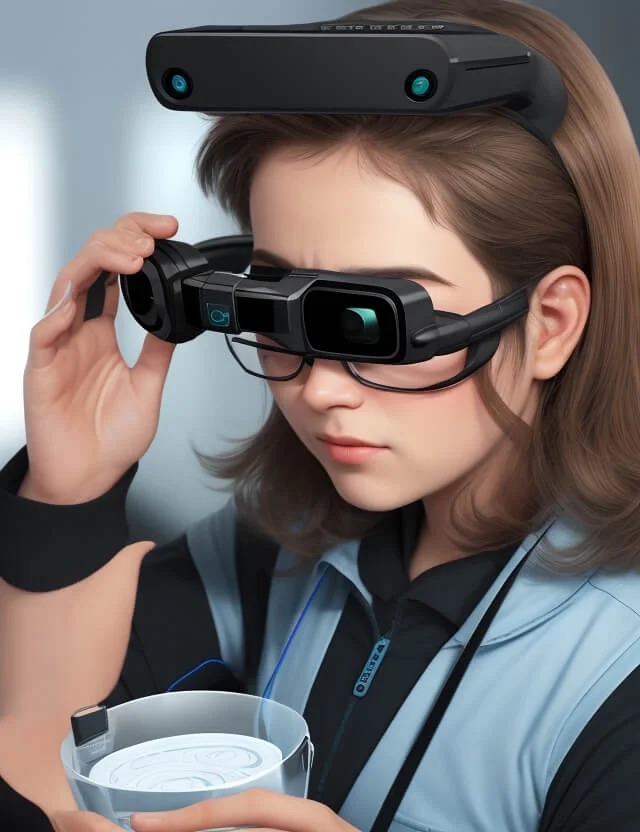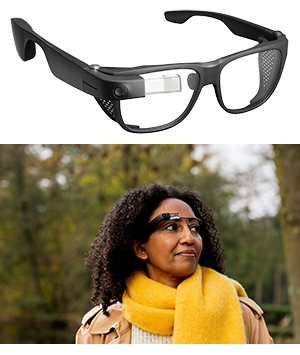Discover Advanced Assistive Devices for People With Aesthetic Disabilities
The landscape of assistive innovation for people with visual disabilities is developing quickly, offering a range of innovative devices that improve autonomy and interaction. From wise glasses that perfectly merge aesthetic input with acoustic support to sophisticated navigation applications that redefine spatial recognition, these devices are reshaping possibilities.
Smart Glasses Innovations
Smart glasses represent a considerable advancement in assistive innovation for people with visual problems. These innovative gadgets incorporate various functions designed to improve the customer's interaction with their environment. Geared up with sensing units and electronic cameras, smart glasses can catch real-time aesthetic information, which is then processed and shared to the user through sound responses or haptic sensations. This performance permits people to receive immediate descriptions of their surroundings, enhancing their capacity to engage and navigate with the world.
Furthermore, developments in fabricated knowledge have actually further enhanced the capabilities of smart glasses. Machine knowing algorithms can recognize faces, reviewed message, and recognize items, making them very useful devices for day-to-day jobs. Individuals can receive auditory signs that give context concerning their setting, cultivating freedom and self-confidence.
In addition, the ergonomic style and lightweight nature of numerous smart glasses make them suitable for long term usage, guaranteeing comfort while boosting capability. As these gadgets continue to evolve, they hold the possible to reinvent the way people with aesthetic impairments experience their lives, linking the space between access and modern technology. The continuous research and growth in this field assurance to increase the opportunities for clever glasses, making them an important part of contemporary assistive tools.
Navigation Application and Tools
Countless navigating apps and devices have arised as important sources for individuals with aesthetic disabilities, significantly enhancing their ability to pass through unfamiliar settings. These technologies utilize GPS performance, audio cues, and real-time data to provide individuals with specific navigation help.
One prominent instance is the Aira application, which connects individuals to trained agents that can give visual summaries of environments and navigating assistance via an online video feed. This solution improves the individual's spatial understanding and confidence while navigating. One more remarkable tool is Seeing Eye GPS, which provides voice-guided navigating and points of passion, enabling individuals to gain access to essential information concerning their environments.

As innovation proceeds to development, the advancement of a lot more advanced navigation tools promises to more encourage people with visual impairments, facilitating smooth flexibility and assimilation into diverse settings. Such technologies are crucial in advertising a more inclusive society.
Braille Technology Advancements
In the last few years, developments in Braille innovation have actually significantly transformed exactly how individuals with aesthetic problems accessibility information and engage with the world around them. The development of portable Braille displays has transformed analysis by enabling individuals to attach wirelessly to smart devices, tablet computers, and computer systems. These gadgets convert text right into Braille in real-time, enabling smooth communication with electronic material.
Furthermore, ingenious Braille printers have emerged, enhancing the manufacturing of responsive materials. Modern embossers are faster and much more efficient, permitting the quick production of Braille records and academic materials. This effectiveness minimizes the time and cost related to producing Braille sources, making them much more accessible to schools and companies.
Additionally, the assimilation of Braille with other technologies, such as artificial knowledge and artificial intelligence, has opened up new methods for individualized discovering experiences. Voice recognition and synthesis modern technologies can match Braille, providing a comprehensive method to information circulation.
As the demand for comprehensive education and office atmospheres grows, these technological advancements play a crucial function in empowering people with visual disabilities, guaranteeing they have equal accessibility to information and possibilities in various facets of life.
Wearable Gadgets for Freedom
A growing variety of wearable devices is improving freedom for individuals with aesthetic disabilities, offering ingenious remedies that improve navigation and day-to-day living. Braille displays and notetakers. These devices utilize innovative innovations to give real-time feedback and support, advertising freedom in numerous environments

Wearable innovation also includes smartwatches that can be set with access functions, allowing users to receive alerts, track their places, and even call for aid with the touch of a switch. Furthermore, some devices incorporate fabricated knowledge to evaluate the atmosphere, offering sound descriptions of nearby objects or individuals.
Voice-Activated Assistive Solutions
Leveraging voice-activated assistive services has actually changed the landscape of support for people with visual problems, offering hands-free communication and access to a selection of tasks. These modern technologies use natural language handling and expert system to enable customers to carry out day-to-day activities with simple voice commands.

Moreover, recent improvements in voice acknowledgment precision have improved the user experience substantially, suiting varied accents and speech patterns. This inclusivity ensures that more individuals can take advantage of these modern technologies, cultivating a better sense of autonomy.
Conclusion
Finally, the Voice-activated assistive devices advancement of sophisticated assistive tools dramatically boosts the independence and quality of life for individuals with visual impairments. Developments such as wise glasses, navigation apps, Braille innovation, wearable gadgets, and voice-activated options collectively promote a more inclusive environment. These technologies empower users to browse their environments with self-confidence and involve more fully with the world, ultimately advertising better availability and level playing fields for individuals facing aesthetic difficulties.
The landscape of assistive innovation for individuals with visual problems is advancing quickly, providing a range of cutting-edge tools that improve autonomy and involvement.Smart glasses stand for a considerable development in assistive modern technology for individuals with aesthetic problems. As these gadgets continue to evolve, they hold the possible to change the way individuals with aesthetic disabilities experience their daily lives, linking the space between access and innovation.In recent years, improvements in Braille innovation have actually substantially transformed just how individuals with aesthetic impairments accessibility information and involve with the world around them. These modern technologies equip customers to navigate their environments with confidence and involve more completely with the globe, eventually advertising greater access and equal possibilities for individuals dealing with aesthetic difficulties.
Comments on “Top Braille Displays and Notetakers to Enhance Accessibility for the Blind”